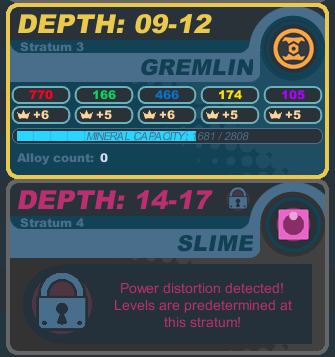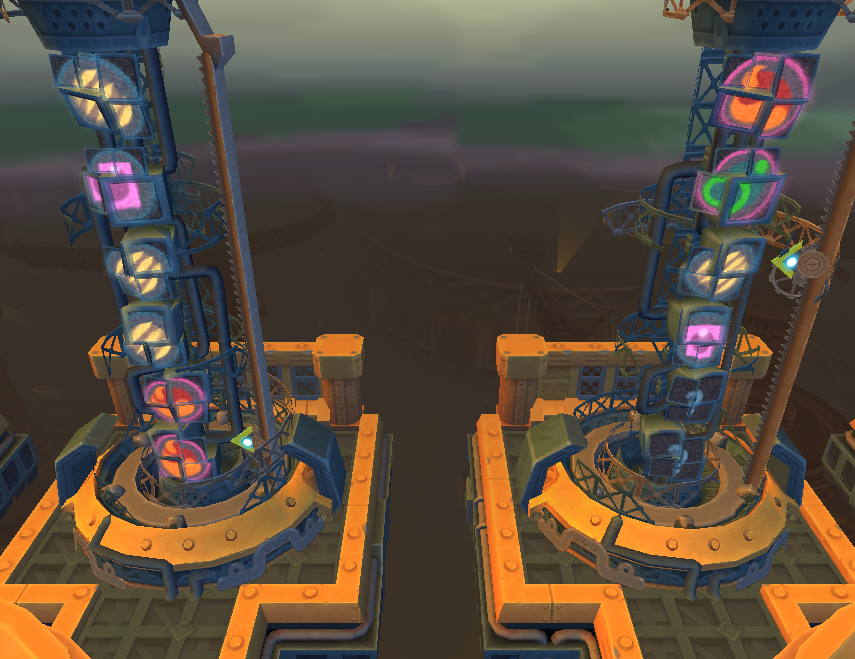Gate construction
From SpiralKnights
Note: A recent update has rendered much of the information on this page inaccurate.
Gates are constructed by putting Minerals into them before they open.
A gate first appears in The Arcade with a countdown timer; typically this has a value from 3 to 5. Every two days, all gates count down by one; if a gate reaches zero, a Dungeon is built. The leftmost gate is removed, and a new, empty gate is cycled in on the right. According to the developers, the initial color/symbol on a gate has no bearing on the levels that will be generated; this is purely an artistic embellishment that makes it easier to distinguish between gates. Once a gate is gone, the unique set of levels with it also disappears; even if the same color/symbol pair appears again, the levels within that gate are determined purely by the minerals deposited.
The replacement of old gates is controlled by The Clockworks, and is outside the influence of the knights.
The knights do have the ability to control the Dungeons that are built; different minerals will generate different types of levels. The minerals that are added, and the way that they are added will affect both the number of levels at each floor, the type of floor, and the depth of the dungeon.
The developers also have the ability to lock gates into producing a particular type of level- this is sometimes done to encourage testing of a level type or boss, and is rarely announced in advance.
Contents
Overview
Stratum
Each stratum can hold a certain number of minerals. Crowns are awarded for each mineral that is deposited into the highest possible stratum. Players who wish to deposit minerals to generate lower depths will pay crown costs. This is to encourage earlier tiers to be completed first.
Power distortions can be found in some stratum. Players cannot deposit minerals in stratum with a power distortion. This is because the dungeons have already been preset, usually including a boss fight before the terminal.
Certain levels are more likely to be formed if a large group of minerals of the same type is deposited. Therefore, it is a bad idea to deposit random minerals as you receive them (in clusters of 1-6 minerals at a time). Instead, save minerals up and deposit them all in once in relatively large and unmixed deposits.
How minerals affect level generation
Mineral types
Based on experiments with gates of controlled mineral composition, the color of mineral deposits appears to influence what gates are created. Two-mineral gates are also being attempted, but preliminary results seem to indicate that this produces two types of levels, with no new levels that would require a mixture.
Pure levels
- "Red" levels: ?
- "Purple" levels: ?
- "Blue" levels": ?
- "Yellow" levels: ?
- "Green" levels: ?
Combination levels
- "Red + Purple" levels: Fiend
- "Red + Blue" levels: Gremlin
- "Red + Yellow" levels: Fire
- "Red + Green" levels: Beast
- "Purple + Blue" levels: Freeze
- "Purple + Yellow" levels: ?
- "Purple + Green" levels: Poison
- "Blue + Yellow" levels": Construct
- "Blue + Green" levels: Freeze
- "Yellow + Green" levels: Slime
Amount of minerals required for gate creation
A developer has confirmed that the number of minerals required to complete each block varies dynamically, based on the number of minerals spawned in dungeons during the previous week.
Reading the "totem" diagram
Behind each gate is a large, colorful diagram that conveys information about what gate progress and what levels will be formed. Although this diagram is not yet completely understood, current working theories are given below.
Gates under construction
While minerals are being added to a gate, the totem diagram consists of a set of 1-6 rings, broken into 20 blocks each. When six full rings are present, the bottom of the diagram will show a white glow, indicating that the gate in question will reach the core.
Each ring represents the distance from one town (or terminal) to the next; a pair of rings represents all gates between two towns. It has been suggested that levels will not be created in that set unless the entire ring has been completed.
The number and type of minerals that has been added to a gate is conveyed in two distinct ways. First, each ring of 20 blocks is broken into colors that relate to the types of minerals deposited (though this relationship is as yet unclear). Second, rising from the center of the gate is a set of bars whose relative heights depend on the relative amounts of minerals that have been added. If three bars are present (red and yellow at equal heights; green half the height of red), then the overall mineral composition of the gate would be 40% red, 40% yellow, and 20% green.
Completed Gates
| This article is a stub. You can help by expanding it. |

